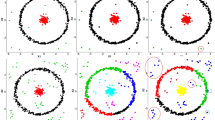Abstract
We present a new clustering algorithm for multivariate binary data. The new algorithm is based on the convex relaxation of hierarchical clustering, which is achieved by considering the binomial likelihood as a natural distribution for binary data and by formulating convex clustering using a pairwise penalty on prototypes of clusters. Under convex clustering, we show that the typical \(\ell _1\) pairwise fused penalty results in ineffective cluster formation. In an attempt to promote the clustering performance and select the relevant clustering variables, we propose the penalized maximum likelihood estimation with an \(\ell _2\) fused penalty on the fusion parameters and an \(\ell _1\) penalty on the loading matrix. We provide an efficient algorithm to solve the optimization by using majorization-minimization algorithm and alternative direction method of multipliers. Numerical studies confirmed its good performance and real data analysis demonstrates the practical usefulness of the proposed method.





Similar content being viewed by others
References
Beck A, Teboulle M (2009) A fast iterative shrinkage-thresholding algorithm for linear inverse problems. SIAM J Imaging Sci 2:183–202
Böhning D (1992) Multinomial logistic regression algorithm. Ann Inst Stat Math 44:197–200
Boyd S, Parikh N, Chu E, Peleato B, Eckstein J (2011) Distributed optimization and statistical learning via the alternating direction method of multipliers. Found Trend${}^{\textregistered }$ Mach Learn 3:1–122
Chi EC, Lange K (2015) Splitting methods for convex clustering. J Comput Graph Stat 24:994–1013
Efron B, Hastie T, Johnstone I, Tibshirani R (2004) Least angle regression. Ann Stat 32:407–499
Finch H (2005) Comparison of distance measures in cluster analysis with dichotomous data. J Data Sci 3:85–100
Goldstein T, O’Donoghue B, Setzer S, Baraniuk R (2014) Fast alternating direction optimization methods. SIAM J Imaging Sci 7:1588–1623
Golub GH, Van Loan CF (1996) Matrix computations, 3rd edn. Johns Hopkins University Press, Baltimore
Hallac D, Leskovec J, Boyd S (2015) Network lasso: clustering and optimization in large graphs. In: Proceedings of the 21th ACM SIGKDD international conference on knowledge discovery and data mining, pp 387–396
Hocking TD, Joullin A, Bach F, Vert J-P (2011) Cluterpath: an algorithm for clustering using convex fusion penalties. In: Proceedings of the 28th international conference on machine learning (ICML-11), pp 754–762
Jolliffe IT (2012) Principal component analysis, 2nd edn. Springer, New York
Lange K (2004) Optimization. Springer, New York
Lee S, Huang JZ (2014) A biclustering algorithm for binary matrices based on penalized Bernoulli likelihood. Stat Comput 24:429–441
Lee S, Huang JZ, Hu J (2010) Sparse logistic principal component analysis for binary data. Ann Appl Stat 4:1579–1601
Li T (2006) A unified view on clustering binary data. Mach Learn 62:199–215
Lichman M (2013) UCI machine learning repository [http://archive.ics.uci.edu/ml]. University of California, School of Information and Computer Science, Irvine
Pan W, Shen X, Liu B (2013) Cluster analysis: unsupervised learning via supervised learning with a non-convex penalty. J Mach Learn Res 14:1865–1889
Polson NG, Scott JG, Willard BT (2015) Proximal algorithms in statistics and machine learning. Stat Sci 30:559–581
Rand WM (1971) Objective criteria for the evaluation of clustering methods. J Am Stat Assoc 66:846–850
Shen X, Huang HC (2010) Grouping pursuit through a regularization solution surface. J Am Stat Assoc 105:727–739
Shen X, Pan W (2012) Simultaneous supervised clustering and feature selection over a graph. Biometrika 99:899–914
Tibshirani R, Walther G, Hastie T (2001) Estimating the number of clusters in a data set via the gap statistic. J R Stat Soc Ser B 63:411–423
Turlach BA, Venables W (2005) Simultaneous variable selection. Technometrics 47:349–363
Witten DM, Tibshirani R (2010) A framework for feature selection in clustering. J Am Stat Assoc 105:713–726
Wu C, Kwon S, Shen X, Pan W (2016) A new algorithm and theory for penalized regression-based clustering. J Mach Learn Res 17:1–25
Yang H, Liu X (2017) Studies on the clustering algorithm for analyzing gene expression data with a bidirectional penalty. J Comput Biol 24:689–698
Yang Y, Guan X, You J (2002) CLOPE: a fast and effective clustering algorithm for transactional data. In: SIGKDD ’02 Edmonton, Alberta, Canada, pp 682–687
Zhang Z, Li T, Ding C, Zhang X (2007) Binary matrix factorization with applications. In: IEEE international conference on data mining, pp 391–400
Acknowledgements
Hosik Choi was supported by the Basic Science Research Program through the National Research Foundation of Korea (NRF) funded by the Ministry of Education (2017R1D1A1B05028565). Seokho Lee was supported by the Basic Science Research Program through the National Research Foundation of Korea (NRF) funded by the Ministry of Education (NRF-2017R1D1A1B04030695).
Author information
Authors and Affiliations
Corresponding author
Electronic supplementary material
Below is the link to the electronic supplementary material.
Rights and permissions
About this article
Cite this article
Choi, H., Lee, S. Convex clustering for binary data. Adv Data Anal Classif 13, 991–1018 (2019). https://doi.org/10.1007/s11634-018-0350-1
Received:
Revised:
Accepted:
Published:
Issue Date:
DOI: https://doi.org/10.1007/s11634-018-0350-1




